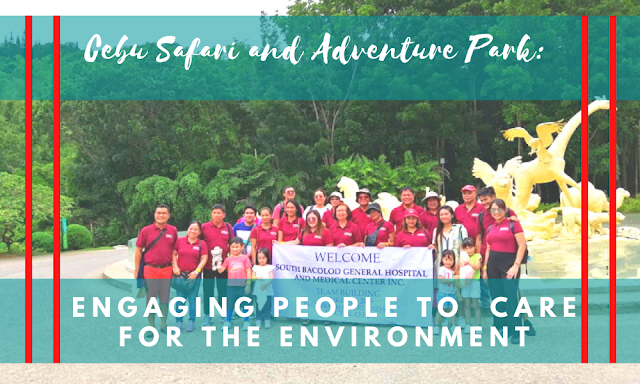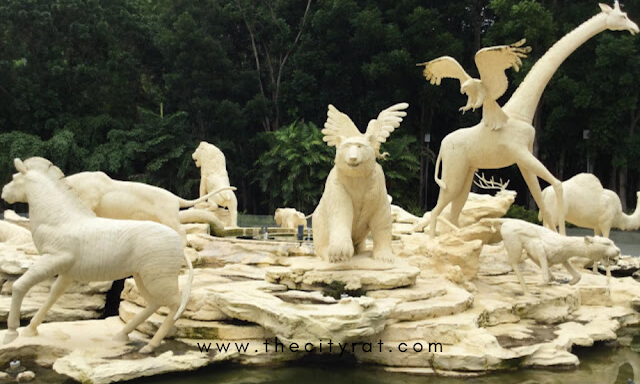I am proud to say that I am one of the privileged few who had traveled to Cebu and visited different tourist destinations for 4 days and 3 nights with above par accommodation; without spending a single centavo.
Thank you to the management of South Bacolod General Hospital and Medical Center, Inc. (SBGHMCI) for being generous with their people. Because without them, the first-ever out-of-town Teambuilding Program, which was held in Cebu City would not have been possible.
As part of our itinerary, we explored the massive and sloppy Carmen town in the northern part of Cebu to experience what it is like interacting with wild animals and communing with nature through the Cebu Safari and Adventure Park.
I guess this is the biggest zoo, so far in the Philippines, occupying more than a thousand hectares of land area, which is home, not only of birds, mammals, and reptiles but also, of extinct species of orchids, cactus and other plants.
We traveled almost two hours from our hotel in Lapu-lapu City, the P
almbeach Resort and Spa before reaching the Safari Fountain entrance.
It helps that we had reserved our slots in advance via the online payment system, otherwise, we will form a queue to be able to get the entrance pass which will take a lot of time and may probably hinder us from covering as many attractions as possible.
After the usual entrance security check, giving of the ID bracelet and an info sheet, we headed to the Base Camp to wait for the tram car to bring us to the other places in the man-made forest.
1. Dome
This is an enclosed dome-shaped structure that gives shelter and enough room for colorful parrots, pigeons, and lories to fly freely.
There were tall trees and plenty of branches, which serves as a resting place of these birds.
2. Macaw Aviary
Home to various colorful macaws with blue, gold and green as dominant colors, the Macaw Aviary is a breeding ground for these birds, guaranteeing that they will not be extinct in the future.
A couple of brilliant-red colored Scarlet Ibis are sharing this space with the macaws.
3. Safari Outpost
This is an open-field area, but seems like the real natural habitat of the dwellers of this place such as reticulated and Rothschild’s giraffes, meerkats, swans, ducks, pelicans, geese, crowned cranes, hyenas, and Bactrian camels.
The Safari Restaurant and Tram Stop are located in this area.
4. Tiger Turf
A combination of big rocks, a small lake, and bushy wild plants in a very wide open area (but with enclosure for public safety) is considered the resting place of around four tigers and two cubs.
I was informed that feeding time is random and the meat is deliberately hidden from the mammal’s view to simulate food hunting.
5. Deer District
In this part of the zafari, we saw blackbucks, deers, Javan Rusas, Visayas Warty Pigs, kangaroos, Wallabies, the regal-bearing peafowls, emus, gibbons, kangaroos, emus, rheas, and capybaras.
6. Orangutown
This massive, sloppy terrain is home to other mammals such as the gibbons, lemurs, orangutans and Celebes Macaques. Just like the lions, management takes efforts to breed the animals in their natural environment.
7. Other Animals
Within their appointed places, we saw Cheetahs, African lions, the big and fat Sulcatta Tortoise, Serval cats, otters, box turtles and almost a hundred crocodiles and big and long reticulated phytons.
8. African Savanna
This is the only guided tour among the many attractions of the zoo. We were made to ride the tram car and passed by the Savanna-like environment wherein we saw zebras, wildebeest, greater kudus, blesboks, elands, impalas, waterbucks, gemsbok, mostly in pairs.
They do not seem to mind the presence of each other because they are more interested in getting their stomach full by eating a lot of food as they roam around the area.
9. Bird’s Show
At around 1:45 PM, we were treated to a one-hour bird’s shows. There were different kinds of performance, such as birds flying in the same direction, making addition and identifying the pictures, etc.
Some birds were made to land atop the hands of an audience or getting a 500-peso bill from the hand of the guest.
10. Flora Walking Trail
Located at the opposite side of the forest, this area features almost a million variety of orchids, all beautifully arranged as if you are in the middle of a castle made of plants and flowers.
If you are fond of taking pictures to post on your social media accounts, then this place is for you.
Final Thoughts
Indeed, Cebu Safari and Adventure Park boast of more than a thousand animals from almost 120 different species, making it the largest in Southeast Asia.
Our visit is an educational and enriching experience. We learned many facts about the animals, their mating habits, monogamous animals, etc.
It made us realize that we should care for the environment because climate change can affect the behavior of animals and their breeding patterns.
Have you been to Cebu Safari and Adventure Park or any zoo in the world? Share your thoughts in the comment section below.
I will be glad to exchange ideas with you especially in caring for the animals and the environment.











